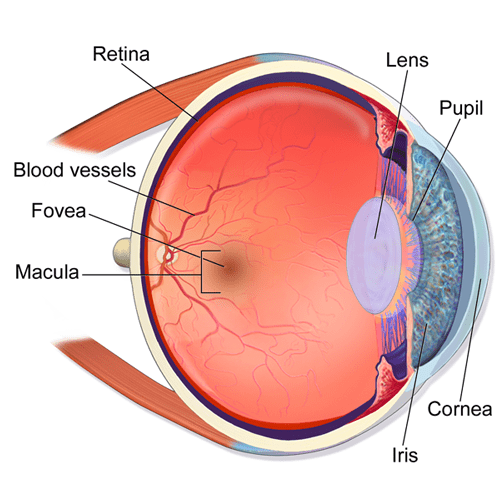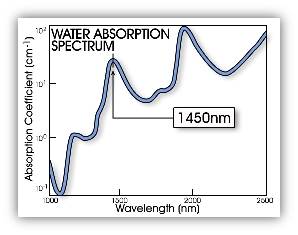As our use of lasers increases, we have a tendency to think of them as commonplace, and we start to forget that these small, often invisible light sources are able to cause permanent damage to our eyes.
WHAT’S THE DANGER?
Exposure to laser light can cause significant damage to the eyes – typically in the form of burns and direct damage to the retina. Traditional eye safety standards focused only on damage to the retina, which can cause permanent injury and blindness. Lasers with wavelengths from 400 nm to around 1400 nm (1.4 µm) travel directly through the eye’s lens, cornea and inter ocular fluid to reach the retina. When the laser energy is absorbed by the retina, it can cause permanent, although not always immediately noticeable, damage. Once a large enough portion of the retina is damaged or the optical nerve is irradiated directly, the loss of vision becomes apparent.

LASERS VS. OTHER LIGHT SOURCES
One of the reasons lasers are so dangerous is that their light is collimated into a small beam, unlike a light bulb or the sun. For non-laser light sources, the energy is diffused over a large area before reaching our eyes (unless you’re looking directly at the sun – which we’ve all been warned not to do, as this will also damage the eyes).
Another danger particular to infrared lasers is their lack of visibility. We can stare directly into the beam of an infrared laser and not see it, as its wavelength is simply not visible to the human eye. Our natural instincts to blink and look away are not triggered, and we feel no discomfort. Since we have no natural inclination to avoid the exposure to infrared laser radiation, we are at risk of being exposed long enough to cause significant damage.
ENTER 1400 NM

Laser wavelengths longer than 1400nm are strongly absorbed in the cornea and lens, thus damaging energy levels often do not reach the retina. Lasers producing light in this range, below a certain power threshold, are essentially “retina safe.”
Retina safe wavelengths allow for higher exposures (longer exposure time and/or higher power) before there is any permanent damage to the eye. The cornea and lens absorb the laser energy, causing them to heat. Typically, the damage (if any) at these higher wavelengths will be to the cornea. The amount of the heat, as well as potential damage, depends not only on the wavelength, but also on the power, beam divergence, beam quality, and length of exposure.
As compared to the retinal damage caused by lasers, most corneal burns caused by lasers will eventually heal, although they can be incredibly painful.
One of the benefits of SemiNex’s laser diodes being in the 1400 to 1700nm range is their relative retinal safety as compared with lasers in other wavelength ranges.
CAUTION IS STILL REQUIRED
As we develop new laser applications, especially those for use in the medical, dermatological, and military arenas, there is an increased focus on preventing damage to both the cornea and the retina. Long term studies of the effects of lasers on the eyes are ongoing, with an emphasis on the long-term impact of exposure. The eye often compensates for small blind spots, so it is common for damage to go unnoticed until it is severe.
It is worth noting that all wavelengths over 1400nm are not equally eye-safe; light with wavelengths of around 3µm and 10µm in particular is more readily absorbed in the cornea. This results in the light being absorbed in a thin outer layer of the cornea instead of being distributed throughout the cornea, and can cause significant corneal damage at much lower exposures than other wavelengths.
Further complicating safety standards, pulsed lasers can produce vastly different effects than their non-pulsed counterparts, even at the same wavelength. The effects of pulsed lasers on the eye are not yet fully understood.
BOTTOM LINE
Since no laser is completely eye safe, it is always advised to use extreme caution and not look directly at the laser. Safety devices must be used when operating a laser. The relative safeness of lasers around 1400nm has led to their increased use in situations where human exposure to the laser is possible or probable. The military in particular has studied laser exposure and redesigned much of their equipment to use lasers in the 1400 to 1800nm range; however, they are also continually looking to improve soldiers’ eyewear to protect against laser damage. Since we only receive two eyes each, it is important to remember that lasers are an invisible danger when we are working with and around them.
FURTHER READING:
May 2014 article in Photonics Spectra: Evolving laser safety standards; embedding lasers in systems to render them Class 1 products
RP Photonics Encyclopedia: Eye safe lasers; also Laser safety – includes simplified descriptions for Laser Safety Classifications
Sam’s Laser FAQ: Extensive coverage of Laser Safety
Synopsis of April 2014 Physical Review Letter: – potential for DNA-level damage from lasers
*Diagram from National Eye Institute, National Institutes of Health, via Wikimedia Commons
